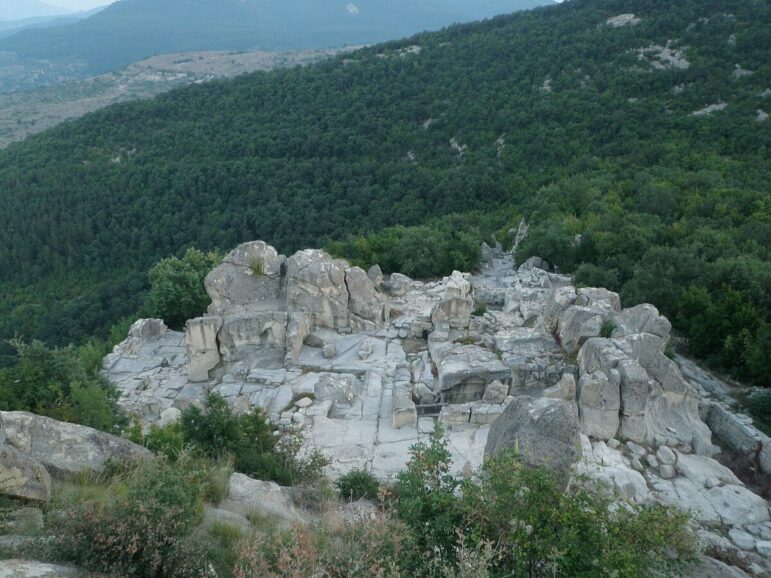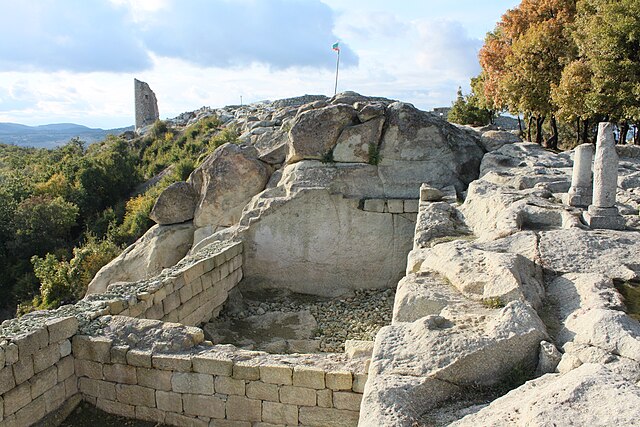SOFIA, Bulgaria – Perperikon is an ancient archaeological site located in the Eastern Rhodope Mountains of Bulgaria, near the town of Kardzhali. It is a significant historical and cultural landmark due to its rich history, which spans several millennia. Last week, Prof. Nikolay Ovcharov, head of the Perperikon excavation team, announced the discovery of two altars, one designated for blood sacrifices, that mark the boundaries of a “sacra” area in the southern section of the archaeological site.
Perperikon is believed to have been an important city of the ancient Thracians, a powerful Indo-European people who inhabited the area. The Thracians used the site for religious and political purposes. It continued to be an important center during the Roman and Byzantine periods. Numerous structures from these periods have been found, including temples, palaces, and fortifications. The site continued to be occupied during the Middle Ages, playing a significant role in the Byzantine-Bulgarian Wars and later serving as a fortress and administrative center for both the Byzantine and Bulgarian empires. It was abandoned in the Late Middle Ages.

Top view of Perperikon [Photo Credit: Renaud71 CCA-SA 3.0]
According to some scholars, Perperikon was one of the most important centers for the worship of Dionysus, the ancient Greek god of wine and fertility. Ancient texts describe an oracle of Dionysus located in this region, which would have attracted pilgrims and seekers of divine wisdom. Several ancient sources and archaeological findings suggest that Perperikon might have been a prominent cult center for Dionysus, comparable in importance to Delphi’s Oracle of Apollo. The site is often linked to various legends, particularly those concerning the Thracians and the ancient worship of Dionysus. Some speculate that Alexander the Great may have consulted the oracle at Perperikon before embarking on his conquests. The city later became a Christian stronghold.
Excavations at Perperikon began in the early 20th century, with more intensive work carried out since the 1980s. Archaeologists have uncovered several rock-cut altars and sanctuaries, which might have been used for religious ceremonies dedicated to Dionysus. These altars, carved directly into the rock, often feature basins that may have been used for libation. Dionysus was central to the Orphic Mysteries, a set of religious practices that originated in Thrace. These mysteries emphasized the soul’s purification and the afterlife, with Dionysus symbolizing death and rebirth, a concept that may have been practiced at Perperikon.
According to Pliny the Elder writing in the 1st century CE, there was an oracle of Dionysus in the region of the Eastern Rhodopes where Perperikon is located. This oracle was believed to be one of the most important centers for the worship of Dionysus, rivaling even the more famous oracles of Delphi and Dodona.
Some scholars have theorized that fire rituals were central to the oracle’s function, where flames interacted with wine to produce divine visions, interpreted by priests as prophecies. They also suggest that the Thracian god Zagreus, son of Zeus and Persephone—who was dismembered by the Titans and reborn—was sometimes identified with an Orphic Dionysus, linked to mystery cults and the cycle of life and death. Another deity, Sabazios, the horseman and sky father, was worshiped in Thrace, and may also have influenced the later understanding of Dionysus.
The latest discoveries at Perperikon focus on the southern quarter of the archaeological site and extend the city’s connection to psychopomps and gods of the underworld.

Perperikon [Photo Credit: Bin im Garten CCA-SA 3.0]
“The altar we are currently uncovering dates back to the Roman era, so we are using data from that period to make a comparative reconstruction. It features a small basin that collects about 5 to 7 liters of liquid. At the end of the basin is a hole through which the liquid drains into several channels, leading to a second basin where the liquid also flows out,” Prof. Ovcharov explained. He believes this altar was likely dedicated to the gods of the underworld. During rituals, participants were dressed in black, and the animals, usually goats or sheep with black fur, were prepared the day before. The animals had to be healthy and willing to go to the altar voluntarily, rather than forced. The head was lowered during the offering to allow the blood to flow into a special pool.
Prof. Ovcharov noted that this altar is related to the 3rd-4th century temples and includes the Temple of the Thracian Horseman, the Temple of Mithras, the Temple of the Ancestors, as well as an unidentified temple discovered two years ago, possibly dedicated to wine. The area also holds several mausoleums which also functioned as temples. “We expect to uncover more finds, the first being these two large sacrificial altars. One was visible before the excavation, but we now have its chronology,” he added.
According to Prof. Ovcharov, the altar may have been an ancient sacred wine altar, dating back to the Late Bronze Age or early Iron Age.
The excavations at Perperikon are ongoing and have continued yearly until early November, weather permitting.
The Wild Hunt is not responsible for links to external content.
To join a conversation on this post:
Visit our The Wild Hunt subreddit! Point your favorite browser to https://www.reddit.com/r/The_Wild_Hunt_News/, then click “JOIN”. Make sure to click the bell, too, to be notified of new articles posted to our subreddit.